1 End of Initial Treatment Summary Record - National Cancer ...
1 End of Initial Treatment Summary Record - National Cancer ...
1 End of Initial Treatment Summary Record - National Cancer ...
- No tags were found...
You also want an ePaper? Increase the reach of your titles
YUMPU automatically turns print PDFs into web optimized ePapers that Google loves.
To assist test communities that have not already identified, developed or adapted other local, nationalor international templates, an example <strong>of</strong> an end <strong>of</strong> initial treatment summary record/ letter template aswell as some standard statement suggestions for inclusion in the summary to the GP have beendeveloped and can be located in Appendices A and B <strong>of</strong> this document.ScopeAll cancer survivors, irrespective <strong>of</strong> whether they are in the immediate post treatment phase,encountering the late effect consequences <strong>of</strong> treatment or recurrent, active or progressive diseaseinvolved in the test community projects, will have the opportunity for a structured approach to be takento addressing their needs through the introduction <strong>of</strong> an end <strong>of</strong> initial treatment summary record/ letter.<strong>End</strong> <strong>of</strong> <strong>Treatment</strong> <strong>Summary</strong> <strong>Record</strong> / Letter ContentThe demographics for the patient should be obtained from their records.To reduce the potential risk <strong>of</strong> harm, the end <strong>of</strong> initial treatment summary record should be structuredto provide clearly identifiable information that will enable the GP and wider primary care team to makeinformed decisions about the care and management <strong>of</strong> the patient.It is advised that this clearly identifiable information is repeated on subsequent letters to the GP to actas a prompt/ trigger as the late effects <strong>of</strong> treatment or disease recurrence may occur several yearsafter the initial end <strong>of</strong> treatment summary record / letter was originated and the patient may bereviewed by different members <strong>of</strong> the practice team when they attend the practice.Irrespective <strong>of</strong> the format adopted the end <strong>of</strong> initial treatment summary record / letter shouldencompass the following information identified as important by both secondary and primary careclinicians:• Diagnosis and date <strong>of</strong> diagnosis• Histology/ staging / grade• Significant clinical findings• <strong>Summary</strong> <strong>of</strong> initial phase treatment and any complications encountered by the patient duringthis period• <strong>Treatment</strong> intent-curative, management <strong>of</strong> active/advanced disease, palliation/symptom control• <strong>Treatment</strong> outcome (and / or expected median survival for this condition) complete remission,partial response, residual disease etc• Possible acute treatment toxicities and appropriate action/ management• Likelihood <strong>of</strong> compromised immunity• Likely risk <strong>of</strong> late effects <strong>of</strong> treatment• Alert symptoms / triggers that merit discussion or referral for a specialist opinion• Likely risk <strong>of</strong> recurrence and trigger symptoms that should alert the GP or other health carepr<strong>of</strong>essional to refer or seek a specialist opinion.• A summary <strong>of</strong> the management plan for the patient following the initial treatment phaseincluding:- Follow Up schedule and format e.g. face to face, telephone, patient self referral- Schedule for any screening, investigation, tests required during this period- Referrals that have been made to other services- Outline <strong>of</strong> ongoing treatment planned and likely duration <strong>of</strong> this therapy.- Actions needed by the GP including symptom management, screening / monitoringinvestigations and medication review.• Notification that the patient should be entered onto the primary care palliative or supportivecare register if applicable for the individual patient.• A summary <strong>of</strong> the information that has been communicated to the patient and /or theircarer/family. A copy <strong>of</strong> the written patient information given to the patient should be includedwith the summary record if appropriate.• Key contact details/local arrangements for urgent discussion/ fast track referral to specialistcancer team and out <strong>of</strong> hour’s service.3
<strong>Treatment</strong> <strong>Summary</strong> <strong>Record</strong> CommunicationA copy <strong>of</strong> the end <strong>of</strong> initial treatment summary record/ letter should be stored in the individual’s recordand copies forwarded to all the pr<strong>of</strong>essionals involved in the individuals care.Dependent upon local practice or policy arrangements the individual should receive a copy <strong>of</strong> theirtreatment summary record or a letter summarising the pertinent information.References(1) <strong>Cancer</strong> Survivors in the US: The <strong>National</strong> Health Interview Study, Hewitt et al,2003 Journal <strong>of</strong>Gerontology: 58(1) 82-91(2) Norwegian <strong>Cancer</strong> Survivor Study: Nord et al, 2005 International Journal <strong>of</strong> <strong>Cancer</strong>,2005 114, 307 316(3) Measuring the Health and well Being <strong>of</strong> <strong>Cancer</strong> Survivors: Outcome <strong>of</strong> On line Population BasedSurvey, Macmillan <strong>Cancer</strong> Support 2008(4) Access to Primary Care Services: Presentation at ‘Making the <strong>Cancer</strong> Survivorship Agenda a Reality’Think Tank Event, March 2008(5) Long Term Care Planning for <strong>Cancer</strong> Survivors; A Health Services Research Agenda, Earle. C.C.,2007,Journal <strong>of</strong> <strong>Cancer</strong> Survivorship 1(1) 64-74AppendicesAppendices A: Example <strong>of</strong> an <strong>End</strong> <strong>of</strong> <strong>Initial</strong> <strong>Treatment</strong> <strong>Summary</strong> <strong>Record</strong> / Letter TemplateAppendix B:Examples <strong>of</strong> standard statements for inclusion in summary record / letter to GP4
Appendix A<strong>End</strong> <strong>of</strong> <strong>Initial</strong> <strong>Treatment</strong> <strong>Summary</strong> <strong>Record</strong> Letter TemplateGP Contact DetailsTrust Logo and AddressDear Dr XRe: Add in patient name, address, date <strong>of</strong> birth and record numberYour patient Mr/ Ms Bloggs has now completed the initial phase <strong>of</strong> the treatment management plan fortheir cancer. A summary <strong>of</strong> the treatment he/she has received to date and the ongoing treatment /management plan for your patient is outlined below.Diagnosis:Date <strong>of</strong> Diagnosis:Significant Clinical Findings: (NB includesecondaries)Histology/ Staging/ Grade:<strong>Summary</strong> <strong>of</strong> <strong>Initial</strong> Phase <strong>Treatment</strong> Delivered:<strong>Treatment</strong> Intent: ( Please specify whether curative,disease/ symptom control or palliation)Possible acute treatment toxicities and / or late effects:Need to stipulate which toxicities and / or late effects and appropriate action.<strong>Treatment</strong> Outcome: (Please specify eg completeremission/ residual disease etc)Alert Symptoms that merit discussion or referral to the specialist team: ( includelikelihood and signs <strong>of</strong> recurrence, progression <strong>of</strong> disease, complications and latetreatment effects)Recommendation that patient is entered ontoprimary care palliative or supportive care registerYes / NOSpecialist Team Fast Track Re-entry ReferralService Contact Details/ Process:This will depend on local arrangementsOut <strong>of</strong> Hours Emergency Specialist ServiceContact Details:This will depend on local arrangementsOngoing Management Plan: ( include follow up schedule and format, schedule forscreening , investigations and tests required during this period, outline <strong>of</strong> ongoingtreatment planned and likely duration <strong>of</strong> treatment)Referrals made to other services: :District NurseSocial WorkerSALTOtherClinical Nurse SpecialistActions needed by the GP: (include symptom management, screening / monitoring, investigations, place on osteoporosis pathway etc)Infection Risk:Specialist Medication Prescribing ArrangementsMedication Review Requirements by GP:( include scheduled date for review, dosagealterations/ discontinuation, investigations etc)<strong>Summary</strong> <strong>of</strong> information communicated to the patient and / or their carer/ family: (and / or attach / enclose copy <strong>of</strong> patient information sheet/survivorship care plan plus benefits / financial advice information given to the patient as appropriate. Please also state whether a DS1500 has beencompleted or a prescription charge exemption certificate has been given or is needed. )Free text box for additional information (include healthy living, ‘exercise’, emotional support that would be beneficial for the patient plus any tumorspecific website information that may facilitate management <strong>of</strong> the patient by the GP)Completing Drs Signature……………………(Please also print name and include contact details)5
Appendix BStandard StatementsCurative IntentMr X has responded well to treatment and would appear to be in complete remission from his diseaseMr X has responded well to treatment and latest results indicate there is no evidence <strong>of</strong> any activedisease.His risk <strong>of</strong> developing a disease recurrence is low or in the x% range.The likelihood <strong>of</strong> his disease returning is lowIf he remains disease free for the next x months/ year then the likelihood <strong>of</strong> the disease returning issmallThere is a an x% risk <strong>of</strong> his disease returning in the next y months / yearsThis patient has a high risk <strong>of</strong> developing neutropenic sepsis in the next x week period. He has beenadvised to contact the ward immediately if his temperature is 38 c on 2 separate recordings an hourapart, he develops rigors or generally feels unwell. If he should contact you or the out <strong>of</strong> hour’s servicein the first instance then please refer him on immediately for admission/ review on the ward.This patient is at medium risk <strong>of</strong> developing endocrine dysfunction associated with their chemotherapyregime and therefore if they should present to you complaining <strong>of</strong> x I would be grateful if you couldcheck their y to confirm or rule out whether this is the cause <strong>of</strong> their symptoms.This patient is at risk <strong>of</strong> developing osteoporosis from their aromatase inhibitors (or steroids) and Iwould therefore be grateful if you could commence them on the osteoporosis pathway/monitoringprogramme.Management <strong>of</strong> active progressive diseaseMr X’s disease appears to be responding to treatment and there is a reduction in x cms <strong>of</strong> the size <strong>of</strong>the tumour on the scan. I therefore plan to give him a further x courses and rescan in y months unlesshis tolerance to the treatment is reduced or there is evidence <strong>of</strong> progression <strong>of</strong> the disease.I would anticipate that Mr X cancer will continue to respond well to the treatment for the foreseeablefuture. If his disease should progress then dependent on Mr x’s agreement and the extent and rapidity<strong>of</strong> the progression we will prescribe x to see whether we can achieve a further period <strong>of</strong> response totreatment.Mr X has had an initial good response to treatment but I anticipate that his disease will progress withinthe next one year period. If this should occur then we may be able to achieve a further response totreatment by changing to y or:If this should occur then it is unlikely that there will be any further treatment available that would besuitable for this patient. You may therefore wish to place the patient on the palliative/ supportive careregister if this becomes this case.PalliationThe aim <strong>of</strong> treatment is to relieve or delay specific problemsIt is not anticipated that this patient’s tumour will respond to the treatment but we hope to see animprovement in the symptoms that Mr X is currently experiencing.While some patients respond well to treatment, I would not be surprised if Mr X died within the nextfew months.This treatment has been given with palliative intent.This patient is appropriate for entry onto your practices palliative and / or supportive care register.I have / have not discussed this with Mr X6



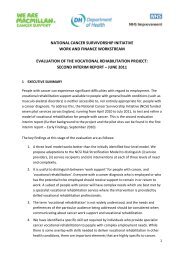
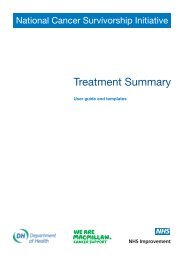

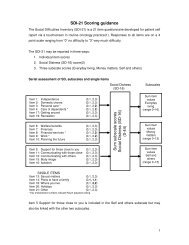

![Download the how to guide [PDF] - Macmillan Cancer Support](https://img.yumpu.com/47067428/1/184x260/download-the-how-to-guide-pdf-macmillan-cancer-support.jpg?quality=85)
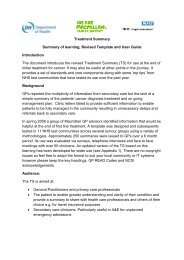

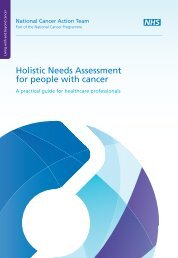
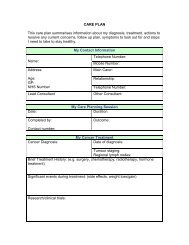



![HOPE Protocol [PDF, 420KB] - National Cancer Survivorship Initiative](https://img.yumpu.com/32566432/1/184x260/hope-protocol-pdf-420kb-national-cancer-survivorship-initiative.jpg?quality=85)